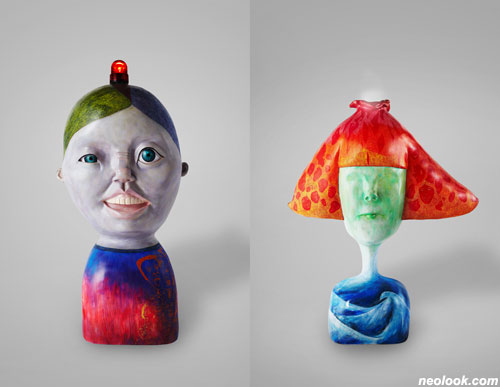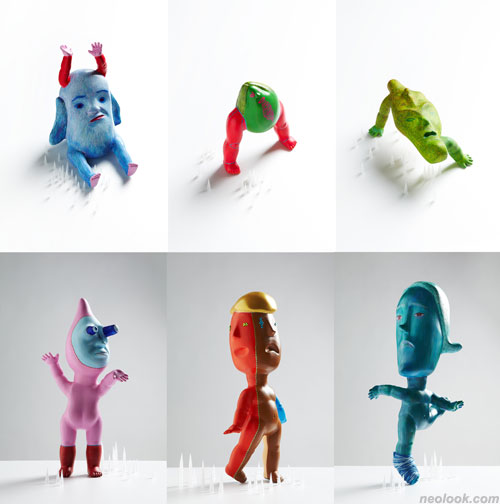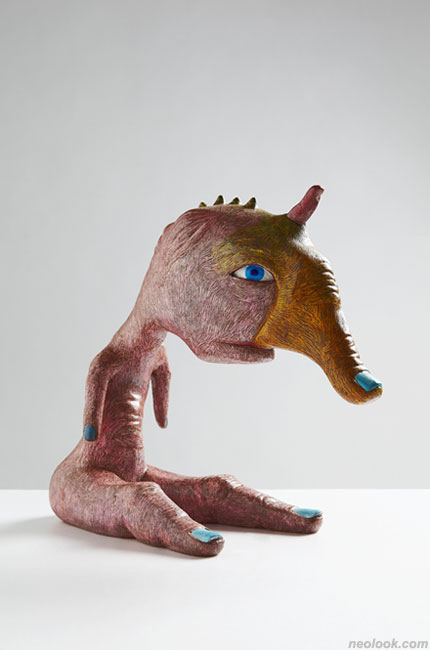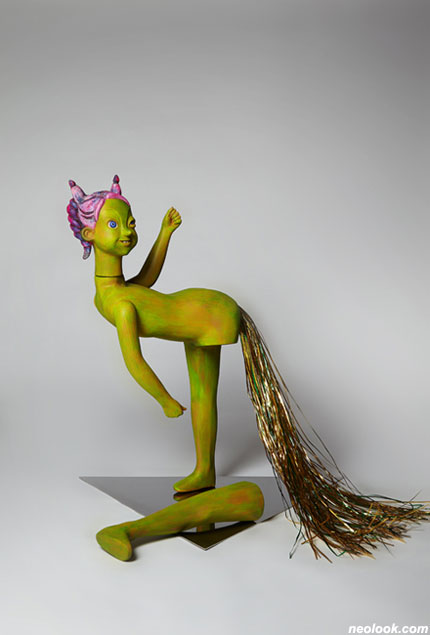아뿔싸! / 홍근영展 / 2011_0615 ~2011_0620 / 가나아트 스페이스
페이지 정보
작성자 art 댓글 0건 조회 4,561회 작성일 11-06-19 20:18| 전시기간 | ~ |
|---|---|
| 전시장소명 |
아뿔싸!
홍근영展 / HONGGEUNYOUNG / 洪根暎 / sculpture.drawing
2011_0615 ~2011_0620
초대일시 / 2011_0615_수요일_06:00pm
관람시간 / 10:00am~07:00pm
가나아트 스페이스 GANAART SPACE 서울 종로구 관훈동 119번지 3층 Tel. +82.2.734.1333
다양체로서의 유기체
홍근영의 작품은 기계와 유기체, 그리고 서로 다른 유기체들이 접합되어 있다. 혼종의 유기체가 그렇듯이 매우 괴상하게 생겼지만 그것은 괴상함을 위한 괴상함이 아니라, 개체를 극단적 상황으로 몰아넣곤 하는 현대 사회에 대한 감정적 반응이 압축되어 있다. 이 전시에서 작가가 주목하는 감정은 화이다. 화라는 감정적 강렬함을 표현하기 위해 다양한 기계적 소품이 동원된다. 소품과 유기체의 결합이 이물적으로 보이지 않는 것은, 유기체와 사물이 서로 결합하기 위해 상호간에 변형이 일어났다는 반증이다. 홍근영의 작품에서 유기체는 물화되어 가고, 사물은 자체의 생명감으로 활기차다. 사이보그, 괴물, 드로잉 등으로 다양하게 형상화된 작품에는 공통적으로 보이는/보이지 않는 뿔이 존재한다. 작가는 '화난다'의 또 다른 표현인 '뿔났다'에 주목하여, 무의식적으로 몸통에서 불쑥 솟아나는 이질적인 싹으로 특정한 감정 상태를 표현한다. 화남, 뿔남은 일종의 긴장상태이지만, 해소되지 않은 긴장상태라는 점에서 불쾌하다.
그러나 긴장을 야기하는 자극은 무감각한 일상의 반복에 발상의 전환을 가능하게 하는 촉매제가 되기도 한다. 그것은 상황을 반전시키기 위한 또 다른 행동을 낳기 때문이다. 「뿔 좀 꺼주세요」 시리즈에서 주체와 기계는 서로 불가분하다. 펠릭스 가타리가 「기계적 무의식」에서 말한 바 있듯이, 모든 물질적 배치의 내부에 일부의 주체성이 관여한다. 반대로 모든 주체적 배치의 내부에 일부의 기계적 제어가 관여한다.

- 홍근영_뿔 좀 꺼주세요1 Turn off the horn1_ 경보등, 합성수지, 크레파스, 아크릴물감, 우레탄 페인팅_175×90×70cm_2011 홍근영_뿔 좀 꺼주세요2 Turn off the horn2_ 안개 발생기, 합성수지, 크레파스, 아크릴물감, 우레탄 페인팅_173×150×70cm_2011
작품 「뿔 좀 꺼주세요」는 윙크하듯이 찡그린 얼굴에, 머리 꼭대기 위에는 경보등이 붙어있어 불이 들어온다. 화가 난 것인지 아닌지 모호한 표정에 비해, 붉은색 경보등은 주체의 상태를 확실하게 전달한다. 머리통 뒤에는 여러 표정의 얼굴들이 새겨져 있다. 크레파스로 그린 후 스크레치 된 드로잉들이며, 인물들은 머리털로 연결되어있다. 뿌리줄기처럼 가느다란 선들은 외양의 묘사이자 감정적 흐름의 표현이다. 하나의 세포에서 분열된 듯한 얼굴들은 한 인물에 내재된 다양한 성질을 표현한다. 단번에 칠한 것이 아니라, 수없이 긁은 방식은 히스테릭한 도상과 잘 어울리는 듯하다.
작품 「뿔 좀 꺼주세요 2」는 마치 독버섯 같이 보이는 붉은 색 단발머리 소녀로, 매우 신경질적으로 보인다. 머리 꼭대기에는 안개가습기가 설치되어 김이 모락모락 나온다. 이른바 '뚜껑이 열린 상태', 즉 폭발하기 직전의 상태이다. 창백한 안색에 표정이 지워져 있어 말로 표현하기 힘든 감정 상태가 응축되어 있다. 몸통은 파도치는 이미지가 새겨져 있는데, 파도는 가슴 속에 일렁이는 어떤 상태를 상징한다. 붉은 색 머리통은 다양한 표정의 얼굴들이 박혀 있어 한 개체 내부에서 무한 분열하는 성향을 드러낸다. 작품 「뿔 파워」는 목에 모터가 달려 있어 얼굴이 돌아간다. 공중 부양하듯이 붕 떠 있는 녹색 몸통에 보라색 머리, 팔다리는 제멋대로이며 머리 스타일이 뿔처럼 위로 솟구쳐 있다. 여기에서 화는 한 개인을 침체시키는 원인이 아니라, 행동을 위한 원천으로 나타난다. 화는 화풀이를 낳는다. 화가 깊을수록 반발력도 거세다.

- 홍근영_뿔이 부르는 노래 Song Horns Sing_싸이키, 합성수지, 크레파스, 우레탄 페인팅_76×60×70cm_2011
작품 「뿔이 부르는 노래」는 머리통 부분에 노래방 용 기계인 싸이키가 돌아간다. 싸이키가 번쩍거리듯이 신나게 놀면서 감정이 고양된 상태이다. 고양된 감정으로 주체할 수 없이 비틀린 몸체에는 다양한 표정의 얼굴들이 새겨져 있다.

- 홍근영_뿔을 보호 합시다! Let's Protect Horns_ 합성수지, 크레파스, 아크릴물감, 우레탄 페인팅_25×20×20cm_2011 HB-56_합성수지, 크레파스, 아크릴물감, 우레탄 페인팅_18×15×10cm_2011 TF-m02_합성수지, 크레파스, 우레탄 페인팅_15×25×15cm_2011 NRP-j2_합성수지, 크레파스, 아크릴물감, 우레탄 페인팅_33×18×12cm_2011 FGG-004_합성수지, 아크릴물감, 큐빅_35×17×13cm_2011 TJGR-888_합성수지, 크레파스, 아크릴물감, 우레탄 페인팅_40×20×20cm_2011
소품인 「뿔을 보호합시다!」 시리즈는 뿔이 존재 변형의 촉발자임을 드러낸다. 여기에서 뿔은 보호할만한 가치 있는 존재이다. 이 시리즈의 하나인 「hb-56」은 녹색 얼굴에 붉은색 다리가 붙어 있다. 생경한 색의 충돌은 그 안에 압축된 에너지를 예시한다. 「fgg-044」는 하나의 몸통에 여러 개의 얼굴이 달린 인형으로, 팔과 다리의 방향이 각기 다르다. 네가지 색면이 조합된 인형의 눈은 다양한 패턴의 모조 보석이 박혀 있다. 그것은 미묘하게 의미를 전달하는 인간의 시선이 아니라, 송신된 메시지처럼 그 의미를 풀어야하는 기계적 코드에 가깝다. 한 몸체와 여러 얼굴은 개체 내부에 똬리를 뜬 수많은 자신들이다. 「nrp-j2」는 보라색 의상에 푸른 얼굴에 심술 맞게 나온 입이 만화 캐릭터 같다. 몸통과 팔의 위치는 제각각에, 눈에는 뿔 같은 말뚝이 박혀 있다. 여기에서 뿔은 가장 중요한 감각기관인 눈과 비교될 수 있는 민감한 촉수로 나타난다. 「뿔을 보호합시다!」의 또 다른 작품들은 몸통이 생략되어 있다. 얼굴과 사지는 몸통에 비해 더 직접적인 감정표현이 가능하다.
조각에 있어서 토르소처럼 몸통만으로 감정을 표현하는 고전적 기술은, 누드가 현대에 와서 쇠퇴해 감에 따라 만들기도 힘들고 공감하기도 힘든 상태가 되었다. 작품 「bms-102」은 보라색 대머리가 그 자체의 몸통이 되어 팔다리가 나온다. 뿔처럼 보이는 위로 올린 양팔에서, 뿔은 호모 파베르를 가능하게 했던 손의 역할로 전치된다. 뿔 자리에 새로운 개체가 돋아나오는 작품 「zk-l7」은 새로운 생성을 위한 자리이며 발생의 흔적이다. 작품 「tjgr-888」에서 푸른 얼굴에 여러 방향으로 뻗는 팔다리는 바른 자세의 정 반대편에 있다.

- 홍근영_Finger-pointing_합성수지, 크레파스, 우레탄 페인팅_30×20×35cm_2011
작품 「finger-pointing」은 크기가 다른 손가락만으로 이루어진 괴물이다. 코끼리 같은 긴 코, 짧은 팔, 퍼져 앉은 다리, 이마 위에 나고 있는 뿔도 모두 손가락이다. 크기만 다른 동질의 것이 조합된 경우여서, 이음매가 어떤 작품보다 자연스럽다. 그것은 혼종을 넘어 새로운 종으로 고양된다.
제목으로 봐서 자화상이 틀림없는 작품 「miss 홍」은 활달한 젊은이 특유의 기표인 총천연색 머리칼과 대조되는 굵은 눈물이 양 뺨에 새겨진다. 여기에는 자유와 소외, 희열과 절망을 동시에 안겨주는 작가로서의 자의식이 드러난다.

- 홍근영_미쓰홍_Miss Hong_합성수지, 크레파스, 아크릴물감, 우레탄 페인팅_42×30×26cm_2011
연필, 볼펜, 색연필, 아크릴 물감, 크레파스 등으로 그려진 드로잉은 조각을 위한 사전 단계에 머무는 것만은 아니다. 인간적인 포즈와 표정이 있는 반인 반수의 괴물이 그려져 있으며, 변형된 다양한 뿔이 존재한다. 뿔은 타인으로부터의 상처의 결과이자, 타인에게 상처를 주는 동인이 된다. 그것은 상처를 주고, 상처 받곤 하는, 인간과 인간 사이에서 벌어지는 감정의 전쟁이다. 홍근영의 작품에서 뿔은 하나의 얼굴 또는 몸통에서 분열 증식하며 또 다른 존재로의 변이를 꾀한다. 뿔은 어떤 감정의 결정체로, 욕망처럼 예측할 수 없는 장소에서 예측할 수 없는 방향으로 뻗어나가곤 한다. 여기에는 이 항목에서 저 항목으로의 끝없는 흐름이 있다. 이러한 과정 중의 주체는 체계의 이익을 창출하기 위해 자신 외부의 힘에 의해 표준화되는 주체화로 고정되지 않는다. 여기에 굳이 어떤 기능이 있다면, 인간 중심주의적인 전망으로부터 벗어난 다수의 특이점들을 운반하는 것에 있다. 그것은 환원이 아니라, 배치를 통해 이루어진다. 다양한 것으로부터 분절된 단편들은 서열관계에 기초하는 체계를 이루지 않는다.

- 홍근영_왜? 드로잉시리즈 Why? Drawing series_종이에 아크릴물감, 크레파스_각 28.5×21cm_2011
홍근영의 작품이 보여주는 자유로운 물질적 배치는 어떤 보편적인 형식을 전제하지 않는다. 그것은 「기계적 무의식」에 언급되듯, 항상 사회의 세력 관계에 의해 위조되어 있는 표상의 세계를 넘어 특이점의 성좌에 속한다. 논리를 벗어나는 이러한 언어는 모든 방향에서 끌어들일 수 있는 배열체계 혹은 모든 방식으로 해석할 수 있는 규칙 체계를 가진다. 이 또 다른 정합적 체계는 주체와의 공명을 목적으로 한다. 그녀의 작품은 서로 다른 존재로부터 온 것일 뿐 아니라, 동일한 범주로 이루어진 작품의 경우에도 스케일의 차이를 보여주기 때문에, 조화로운 결합은 늘 배반된다. 그것은 미와 숭고를 구별한 칸트의 미학처럼, 합목적적인 형식과 한계를 벗어난 반(反)미학이다. 자연적인 질서와 통일성이 파괴되어 있는 불가해한 존재와 사건의 세계는 자체의 한계에 충실함으로서 생겨나는 미가 아니라, 숭고라는 역설적인 쾌락을 발생시킨다. 홍근영의 작품은 개념적으로는 다양한 범주, 물질적으로는 다양한 부품들이 조립되어 작동한다는 점에서 기계적인데, 이 기계는 이질적인 것들과 접속하면서 총체적 구조를 파괴한다.
다양한 방식으로 돋아나는 뿔, 그 이질적 존재는 얼굴에 전체화할 수 없는 강렬한 다양성을 집약한다. 이러한 얼굴은 「기계적 무의식」에 규정된 '자본주의적 안면성'과 다르다. 저자들에 의하면 자본주의적 안면성은 모든 것이 예측되고 계산되며, 무한한 통사법적 검증으로 안면성의 체계적인 구획이 가능해진다. 우주와 동식물-되기의 다양한 눈이 사라지고, 하나의 중심적인 눈이 대신 등장한다. 홍근영의 작품은 이 중심적인 좌표계로부터 벗어나는 뿌리 줄기적 탈주선이 있다. 뿔은 다른 존재로 분기하는 지점, 분화의 가상적 선을 내포한다는 점에서 새로운 배치를 위한 원동력이다. 뿌리 줄기적 방식은 다양체를 낳는다는 점에서 창조적이다. 들뢰즈와 가타리는 「천개의 고원」에서 늘 계보적인 무언가를 전제하는 나무의 방식과 그렇지 않는 뿌리줄기의 방식을 대조한다. 그들에 의하면 리좀은 언어를 다른 차원들과 다른 영역들로 탈중심화시킨다. 리좀 모양의 다양체는 주체도 객체도 없다. 다양체가 가질 수 있는 것은 규정, 크기, 차원 들 뿐이다. 다양체들는 연결접속들을 늘림에 따라 반드시 본성상의 변화를 겪게 되는데, 배치물이란 이러한 다양체 안에서 차원들이 불어난 것이다.
작품 「finger-pointing」는 그러한 다양체의 한 예이다. 다양한 크기의 손가락으로 이루어진 이 개체에서 측정단위들은 발견되지 않기 때문이다. 여기에는 측정의 다양체들 또는 측정의 변이체들 만이 있을 뿐이다. 들뢰즈와 가타리의 「천개의 고원」에 의하면, 통일성(=단위)이라는 개념이 나타나는 것은 하나의 다양체 안에서 기표가 권력을 장악하거나 아니면 그에 상응하는 주체화 과정이 생겨날 때 뿐이다. 이런 식으로 주축-통일성과 하나가 생겨난다. 이와 반대로 다양체들은 바깥, 즉 추상적인 선, 도주선, 또는 탈영토화의 선에 의거해 정의된다. 다양체들은 현실이며 어떠한 통일도 전제하지 않는다. 그것은 결코 총체성으로 들어가지 않고, 주체로 되돌아가지도 않는다. 그것은 나라고 말하든 말하지 않든 더 이상 아무 상관이 없는 지점에 이른다. 이를테면 다양체로서의 홍근영의 작품은 신-인간중심주의의 원형적 질서를 이루는 유기적 총체성으로서의 몸을 탈피한다. 그것은 저자들이 개념화한 '기관 없는 몸체'이다. 기관 없는 몸체는 끊임없이 유기체를 해체하고 탈 기표 작용적 입자들, 즉 순수한 강렬함을 끊임없이 통과시키며, 스스로에게 여러 주체들을 귀속시켜 강도의 흔적만을 남긴다. ■ 이선영
Organisms as Manifolds
Hong Geun-young's work shows a marriage of organisms and machines. Like hybrid organisms, her organisms look uncanny. Her organisms, however, are not to demonstrate bizarreness but to connote an emotional response to contemporary society leading individuals to extreme situations. The emotion Hong is attentive in this show is anger. She exploits a variety of mechanical props to express the emotional intensity of rage. In her work tiny things are harmonized with organisms; they are fused in a modified state. In Hong's work organisms are objectified, and things appear with their own life force. Her works and drawings of cyborgs and monsters have in common visible or invisible horns. Paying attention to '뿔났다' (get angry or get mad / '뿔' here refers to a horn in Korean), she represents a specific emotional state with horns protruded from the body. Being mad is a state of tension in which one feels disagreeable.
Stimulations creating tension can become a catalyst for senselessly recurring daily routines. They can also create action reversing a situation. In the series Soothe Your Anger the subject appears inseparable from a machine. As Felix Guattari stated in L'inconscient machinique, the subject engages in all physical arrangements. In contrast, some mechanisms engage in subjective arrangements. Soothe Your Anger features a figure with the frowning face and a flashing light lamp on her head. While it is ambiguous if she is angry or complacent, this red lamp obviously indicates her emotional state. Faces with diverse facial expressions are portrayed on the back of her head. They are drawings scratched after being rendered with crayons, with thin lines depicting the flow of emotions. Each face represents a character inherent in a person, and the scratching expresses hysteric icons.
In Soothe Your Anger 2 a girl with red hair looks like a poisonous mushroom and appears extremely nervous. A humidifier puffing out steam is set on her head, hinting at a state on the verge of explosion. Her pale complexion and expressionless face implies her tough emotional state. The waves depicted on her body are symbolic of her turbulent mental state. Her red head depicted with facial expressions imply an individual's complex character.
In Horn Power the figure's head can be turned, as a motor is built in its neck. Its green body levitates, its purple head, legs, and arms move freely, and the hair looks like horns. Anger here is not a cause leading an individual to depression but the spring of lively action. One who gets angry needs to vent it. In Song Horns Sing, a psychedelic light lamp used in a noraebang (karaoke) is set on a figure's head and rotates, representing a figure playing with joy in a state of elevated emotion. Faces with diverse expressions are depicted on its twisted body.
Her small series Let's Protect Horns shows horns are stimulators modifying form. One of the series - hb-56 - has the green face with the red legs. A collision of strange colors hints at compressed energy within. Another work - fgg-044 - is a figurine with one body, many faces, and legs and arms in different direction. Paste-gems are embedded in the eyes of the figurine represented with four color fields. The eyes are closer to mechanical codes than to the human gaze. One body and many faces symbolize many egos within an individual.
nrp-j2 with the green face and protruded mouth in purple attire looks like a cartoon character. The body, each leg and arms are in abnormal position, and stakes like horns are in its eyes. The horns are metaphors for eyes. Another work in the Let's Protect Horns series is without a body. The face and the limbs ensure more direct emotional expression than the body. In bms-102, arms and legs come out from a bald head in purple. In zk-17, places for horns are marks for new generation. In tjgr-888 arms and legs spreading in many directions from a blue face are set in abnormal positions.
Finger-pointing is a monster composed of fingers of different size. A long elephant nose, short arms, spreading legs, and horns on a forehead are all expressed with finger shapes. It looks more natural than any other combination with merged things as fingers in different sizes. It was developed into a new species beyond a hybrid. In the self portrait Miss Hong, colorful hair typical of youngsters contrasts with big tears on the cheeks. This work suggests her self consciousness undergoing freedom, alienation, joy and despair.
Hong's pencil, pen, acrylic, and crayon drawings portray half-man and half-animal monsters in human-like poses and facial expressions with diversely modified horns. They are not only for her sculptures. The horns result from wounds caused by others, and also hurt others. They are a metaphor for emotional conflict among humans. In Hong's work horns proliferate from face and body, transforming into another being. As an emotional crystal, horns spread toward unpredictable places and directions: there is an endless stream here. In this process, the subject is not standardized to attain systematic gain. Diverse singularities occur here, deviating from human-centered perspectives.
Hong's work does not presuppose universal form in unrestricted arrangements of organs and things. As in L'inconscient machinique, it belongs to a singular constellation beyond a world of representation influenced by social power. This logical language has a system of arrangements drawn from many directions and a system of rules interpretable in many ways. Her work undermines harmonious marriage as it comes from different beings and things, and is made of the same element in different sizes. As with Immanuel Kant's aesthetic philosophy, distinguishing the beautiful and the sublime, her work in counter-aesthetics deviates from teleological form and limit. The world of inexplicable beings and events where natural order and unity remain in ruin gives rise to a paradoxical pleasure of the sublime. Hong's work is mechanical in that it works through an assembly of diverse categories and parts. When this mechanical trait is fused with the heterogeneous, it destroys comprehensive structure.
Variously spreading horns connote diversity not confined to the face. The face here is different from 'capitalistic faciality' defined in L'inconscient machinique. According to this book's author all are predicted and calculated in this 'capitalistic faciality'. As diverse eyes disappear, one pivotal eye appears instead. There is a rhizomic line of flight in Hong's work. The horns in her work are the motive force for new arrangements in that they connote imaginary lines of differentiation. A rhizomic way is creative in that it brings about manifolds. In A Thousand Plateaus Gilles Deleuz and Felix Guattari contrast the way of trees always presupposing something genealogic with the way of rhizomes. For them, a rhizome decentralizes language, and rhizome-shaped manifolds have not subject and object. These manifolds only have rule, size, and dimension. Things arranged are those with increased dimensions within these manifolds.
Hong's Finger-pointing is an example of such manifold. According to A Thousand Plateaus by Deleuz and Guattari, the concept of unity gives rise to only when the signifier grasps power within a manifold, or a process of subjectificatiion echoing to this takes place. This manifold is defined by exterior, abstract lines, lines of flight, or lines for deterritorialization. Manifolds are reality and do not presuppose any unity. They never return to comprehensibility and subjectivity. Hong's works as manifolds depart from the body as organic comprehensibility forming the archetypal order of neo-humanism. They are 'bodies without organs'. The bodies ceaselessly deconstruct organisms and leave marks of intensity by imputing many subjects to themselves. ■ Lee Sun-young
추천0
 admin님의개인전소식 관련글
admin님의개인전소식 관련글
- H인기글 신은섭 fine tree 올려보기 10-18
- H인기글 두 개의 태양, 두 개의 달 07-25
- H인기글 <삶 - 여정> 07-22
- H인기글 촉발 affect 소영란 07-10
- H인기글 김동수 개인전 <행행전> 07-08
- H인기글 권숙자 초대전 <이 세상의 산책> 06-26
- H인기글 바람이 그린 그림 06-20
- H인기글 강미선 개인전 06-05
- H인기글 김화수 초대개인전 06-05
- H인기글 박건우 초대전 06-05

